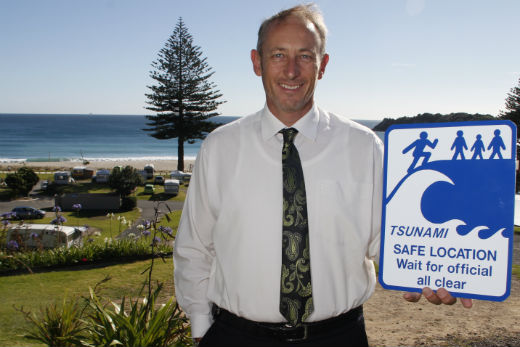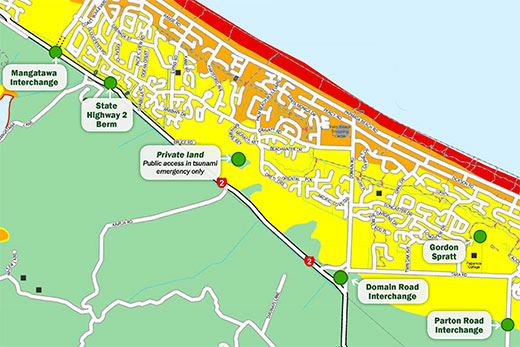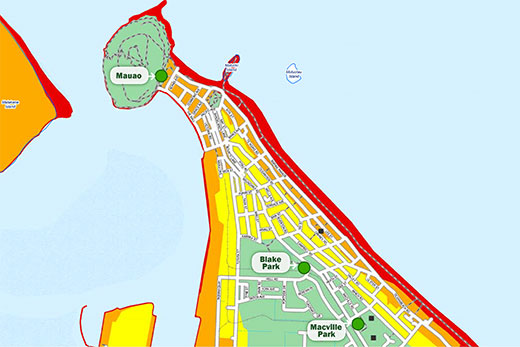Mount Maunganui and Papamoa residents concerned with the distance to their nearest tsunami evacuation route, might be pleasantly surprised just how close they really are.
That's the message from Tauranga City councillor Steve Morris ahead of a series of tsunami open days which start tomorrow.
Tauranga City Council emergency management and safety manager Paul Baunton with one of the new tsunami evacuation signs. Photo: Tracy Hardy.
From 10am-12pm and 4pm-7pm, council staff and consultants will be on hand at the Papamoa Community Centreto discuss any issues including where tsunami waters would go, where the safe zones are going to be, and future tsunami evacuation signage.
Part of council's push to ensure the public know what to do if a tsunami hits and to address any concerns.
This open day is followed by one Club Mount Maunganui on Thursday, ASB Arena on July 7 and Gordon Spratt Reserve in the Dunes Room on July 8.
According to council, the three key issues the public need to know to survive a tsunami are; when to evacuate, where to evacuate and how to evacuate.
Steve, a Mount Maunganui/Papamoa ward councillor, says it's been part of the current council's plan to make sure those in harms way are able to get to safety or be safe.
Whereby council has heeded the publics call to put planning into practice by spending $3.3million on evacuation routes as the first measure.
'If you want people safe you have to unlock the gates and get them to places where they are safe.”
And people might be surprised at just how close the evacuation routes actually are.
'There has always been this misnomer that you have to get into your cars and head straight for the Papamoa Hills. And we are bringing the safe zones down into Papamoa so people are an easy walk away.
'I believe some of the tsunami evacuation bridges are about 400m apart in Papamoa,” says Steve. 'People need to know where the safe places are.
The first evacuation route signs were installed at the Mount last December in collaboration with Bay of Plenty Civil Defence Emergency Management Group, NZ Transport Agency, NZ Police, NZ Fire, and the District Health Board.
The aim of each evacuation route is to direct people to a tsunami safe zone that can be reached on foot within 40 minutes.
Tauranga City Council emergency management and safety manager Paul Baunton says the meetings are an 'open forum” for the public to have a talk about anything tsunami related.
He says hasn't added to its tsunami evacuation signs since December 2013 as it wanted to have a 'good handle” on where the waters would go and where the best evacuation spots are.
'From Mauao through to the end of Papamoa East it's a really big issue for a significant part of the community.
'It's really to give people a forum just to come and have a chat about anything related to that particular topic.”
The new evacuation zone maps are available at: www.tauranga.govt.nz/tsunami
Tsunami Open Days:
July 1, Papamoa Community Centre - 15 Gravatt Road (Tohora Room)
July 2, Club Mount Maunganui - 45 Kawaka Street (Upstairs)
July 7, ASB Arena - 81 Truman Lane (Upstairs)
July 8, Gordon Spratt Reserve - Parton Road (Dunes Room)
Open day hours are: 10am-12pm and 4pm-7pm.
Key:
Red zone: Every tsunami will affect this part of the coastline. You should always evacuate this area if there is any sort of tsunami warning, whether that warning comes from unofficial sources, official warnings or natural warning signs.
Orange zone: In a formal Civil Defence evacuation you may be asked to move from the orange zone into the yellow zone. Tsunami from regional or distant sources (further away than 1000km) could take anywhere from 2-to-12 hours to arrive. You won't feel an earthquake for this type of tsunami so this is where warning systems, text alerts, emails, TV/radio and social media are important.
Yellow zone: The most devastating tsunami, similar to the one that hit Japan in 2011, is predicted to flood the yellow zone. There is a very low chance this will happen in our lifetime, but if it does there will be no time for official warnings. After a major earthquake it would take about 50 minutes for this tsunami to reach the coast, plus another 30 minutes to flood the yellow zone. The further into the yellow zone you get, the shallower and slower moving the water will be. If you plan ahead and evacuate as soon as you can after that first earthquake you have a very good chance of surviving.





8 comments
oh god
Posted on 30-06-2015 17:11 | By Capt_Kaveman
another make up job to suck off
OMG
Posted on 30-06-2015 22:45 | By The Caveman
How many consultants were paid 1000
Can't be bothered
Posted on 01-07-2015 09:21 | By How about this view!
to read the full piece. If you're particularly worried about Tsunami...... MOVE HOUSE! Why should Ratepayers pay for your choice to live where YOU choose to live???? USER PAYS!!!
stating the bleedin' OBVIOUS!
Posted on 01-07-2015 09:43 | By Captain Sensible
I assume every property in the WBOP got a letter with the same pictures as above. The cost of postage alone....Talk about stating the bleedin' OBVIOUS!
Don't blame council for this
Posted on 01-07-2015 11:30 | By BullShtAlert
A lot of people screamed and moaned about the danger from a tsunami and so the bureaucrats are putting in place these things that as far as I believe won't make a difference. Can you imagine residents heading for a tsunami platform rather than then hills? What happens when the tsunami platform is full, or it's just a bit too low for the tsunami wave? I think most people who chose to live only a little above sea level are quite aware of and should be prepared to take the risk.
Too expensive
Posted on 01-07-2015 15:08 | By Towball
To develop suitable land is the councils logic so would much rather spend millions of dollars with sticking plaster solutions . Perhaps council could supply floaties to all the fools who live at sea level with global rising water levels that all world Governments attended three or more years ago . Save your shopping bags fill them with sand . THE Highlander .
This 'discussion'
Posted on 01-07-2015 15:39 | By earlybird
is a classic example of how you can't please everybody. A year or two ago this forum was full of criticism because TCC were doing nothing. Go figure!!!
Ambulance
Posted on 01-07-2015 16:41 | By Jitter
Great stuff that we have these pretty maps and directions where to go and how to get there. However this is the ambulance at the bottom of the cliff as we still need a universal warning system first so we know it is time to get out. TCC/Civil defence say if an earthquake goes on for more than a minute and it is strong enough to knock you over GET OUT. Great stuff especially if you are knocked over and injured and then can't get out. On top of this we are told it takes Civil Defence an hour up to two hours to get into action. Amazing, they should be a rapid response organisation not a "let's wait and see" outfit.Lets have some decent warning sirens. It's better to have too many false alarms rather than none at all.
Leave a Comment
You must be logged in to make a comment.